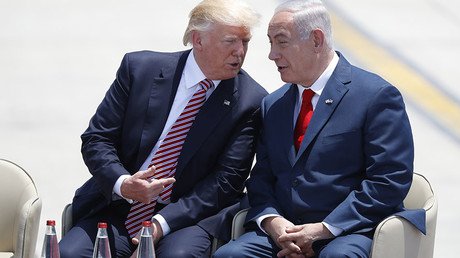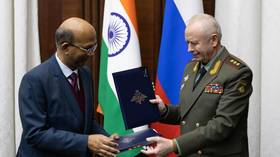2017: A Year of Change... and No Change

Charles Shoebridge takes a look at some of the last year’s security and foreign policy developments.
The Arrival of Trump
One year ago, expectations for 2017 were running high. Donald Trump was about to take office, and predictions ranged from a new era of US policy pursuing peace and international partnership, to the US becoming a puppet of Russia, and even World War III. Of course, none of these happened, and such forecasts now seem as fanciful as they probably should have at the time.
On the day of his inauguration, I suggested that Trump’s evident ignorance of foreign and security issues, combined with his lack of loyal allies within Washington’s political establishment, would make him vulnerable to the pressure and influence of the politicians, officials, think tanks, lobbyists, advisors and journalists representing the same special interest groups that had long driven US foreign policy. Within weeks, Trump confirmed senior officials with largely the same hostility for example towards Russia and/or Iran that might have been expected of Hillary Clinton.
Seeing him as a threat to the established order, elements within what might be called the Deep State targeted Trump in a relentless campaign to undermine his credibility and threaten his removal from office. Perhaps fearing international isolation if Trump delivered on his campaign promises to restore good relations with Russia and end US support for the war in Syria, the intelligence services of the UK appear to have been a key driver of this.
Regardless, UK PM Theresa May rushed to be the first leader to pay homage to the new US president, while Trump left no doubt as to US priorities by making Saudi Arabia and Israel his first overseas visits – coinciding with a massive Saudi arms deal and planned increase in US military aid to Israel.
For the Washington lobbyists and US foreign policy establishment, this was business as usual. Yet it was in respect of Syria a month earlier that Trump learned how he was expected to behave.
Syria, Iraq and the Middle East
In response to an alleged chemical attack at Khan Sheikhun in April, Trump without waiting for any investigation launched cruise missiles at Syrian forces – reversing his and the previous Obama administration’s stated policy of non-overt intervention in Syria. In doing so, he immediately gained the (albeit short lived) approval of the same US politicians and media who for months had remorselessly condemned him.
Trump’s missile attack was largely symbolic however, causing little damage to Syria’s military capability and having no impact upon the largely successful prosecution of the war against Islamic State, Al-Qaeda and other rebel groups that over the last year has arguably brought the country now closer to a restoration of peace than at any time since 2011. This was helped not only by the military support of Russia and Iran, by also by their cooperation with Turkey in attempting to forge a realistic peace process, with the long and destructive ‘Assad must go’ mantra of the US and its allies now rendered irrelevant.
2017 was particularly a year of relative tranquility for the people of Syria’s largest city Aleppo, which until its retaking by Syrian forces in December 2016 had for years been largely occupied by US UK backed, Islamist dominated rebels.
US UK politicians and media had for months daily warned that massacres would be perpetrated by the Syrian government “if Aleppo fell,” but these didn’t occur – just as they also hadn’t occurred in other recaptured cities, such as Homs. Meanwhile, throughout 2017 displaced civilians began returning in large numbers to their homes – suggesting that US UK claims that it had been Assad they’d been fleeing from, rather than war or the rebels the US and UK had backed, were likely wrong.
While perhaps forced to do so by the reality of the battlefield, Trump did honor his pledge to stop US funding and arming of Syria’s rebels. With it largely at an end, the massive scale of the arming program was at last publicly revealed, laying to rest the long US UK media-propagated myth of US UK policy in Syria having been one of non-intervention.
Not only did the arming of Syria’s rebels fuel and prolong a war that has killed some 400,000 people, but also many of the arms supplied by the US and its allies ended up in the “wrong hands” of the same Islamic State and Al-Qaeda terrorists the US and its allies were purporting to fight.
This of course was exactly as many had long predicted – and indeed was so predictable that some suggest so-called ‘moderate’ rebels were supplied with often sophisticated weapons in the knowledge they would be passed to extremists who, from the war’s outset, comprised the most effective fighting force against Assad.
Such a scenario would not be a surprise. After all, the US and its allies have long regarded Islamist forces as a useful foreign policy tool, regardless of their disdain of democracy, human rights or other claimed ‘US values.’
Even three years after its air campaign to “degrade” IS began, evidence continued to emerge over the last year to suggest the US and its allies still see IS as much as an asset as an enemy to be destroyed. In December 2016 for example, despite intensive US surveillance, IS forces were able to cross open desert to attack Palmyra, just at the time US backed rebels were under intense military pressure in Aleppo.
Similarly, the US reportedly facilitated the escape of IS fighters from Raqqa, and appeared to strike a deal with IS fighters to allow the US’ SDF proxies an unopposed advance in their race to seize Deir ez-Zor oilfields, thereby preventing their retaking by forces loyal to Assad. This illustrates how even now, the uninvited and hence unlawful US presence in Syria continues.
As in Syria, 2017 also saw IS largely defeated in Iraq. US-led airstrikes undoubtedly played a role in this – but at great civilian loss of life that barely featured in US UK media, unlike the daily coverage of alleged mass civilian casualties when Syria and Russia were, for example, carrying out operations in Aleppo. Indeed, only now is the extent of US-led killing of civilians in, for example, Raqqa and Mosul starting to receive prominent coverage in US UK media.
The same applies to the Saudi air campaign and blockade against Yemen which, using US and UK supplied weapons, continued throughout the year at catastrophic civilian cost, yet which receives only infrequent and mainly uncritical coverage in a US UK media that mostly would rather parrot US and Israeli claims that Iran is the source of the region’s instability.
Terrorism
Predictably, IS losing their physical ‘caliphate’ didn’t end terrorist attacks elsewhere. In April, an attack on the St. Petersburg Metro killed 15, and 8 died in Manhattan. Attacks in Syria, Afghanistan, Libya, Somalia, Egypt and elsewhere killed very many more.
The UK suffered its worst incidents since 2005, including 22 killed in Manchester in what appears to be one of the clearest examples of blowback resulting from the policies of the UK government and its intelligence services in facilitating the destabilization of states such as Libya.
Russia, Russia, Russia
2017 was the year Russia was blamed by Western politicians and media for everything. Notably, this wasn’t only the usual ‘Russia threat’ stories of aircraft and ships that turn out to be entirely routine, in international waters and airspace, and which when the same activities are carried out by NATO forces are instead described as ‘a response’ or ‘reassurance.’
Russia was also blamed for cyber-attacks, despite little evidence being offered, and despite that in some cases the blame for the attack seemed to shift according to which ‘enemy’ state was most in need of vilification at the time. For example, a hacking of emails of UK parliamentarians was first blamed on Russia but later on Iran, whereas another attack was blamed first on Russia, then on North Korea.
In reality, accurate attribution in cyber-attacks is notoriously difficult – particularly given that the CIA and doubtless others have developed tools specifically designed to blame attacks on those innocent of them.
Throughout 2017, it was also repeatedly reported that Russia is interfering in other countries’ elections and referendums. These claims are often reported as fact yet, despite long running and intensive investigations, the hard evidence to support such allegations remains almost entirely absent – for example in Germany, France, the US and the UK.
US Decline?
The recent UN votes against Trump’s decision to recognize Jerusalem as Israel’s capital, and for example the US position on climate change and Iran, show a US arguably more isolated from world opinion, including even its close allies, than at any time in recent history.
Yet rather than work to cultivate partnerships to deal with common issues such as Korea or terrorism, the US continues to publicly designate potential allies as enemies, as for example in its recent security strategy document – and to seek confrontation rather than cooperation, as arguably in its decision to send arms to Ukraine.
The US remains the world’s most powerful nation. But unless it can learn to carry its immense power more softly and responsibly, to act in the interests of peace, stability, of its own people and the wider world rather than in the narrow interests of those that often appear to be driving its policies, its influence in an increasingly multipolar world will likely decline. If 2017 is any guide, it seems perhaps even less likely now that Trump will prevent this than it did a year ago.
The statements, views and opinions expressed in this column are solely those of the author and do not necessarily represent those of RT.




















